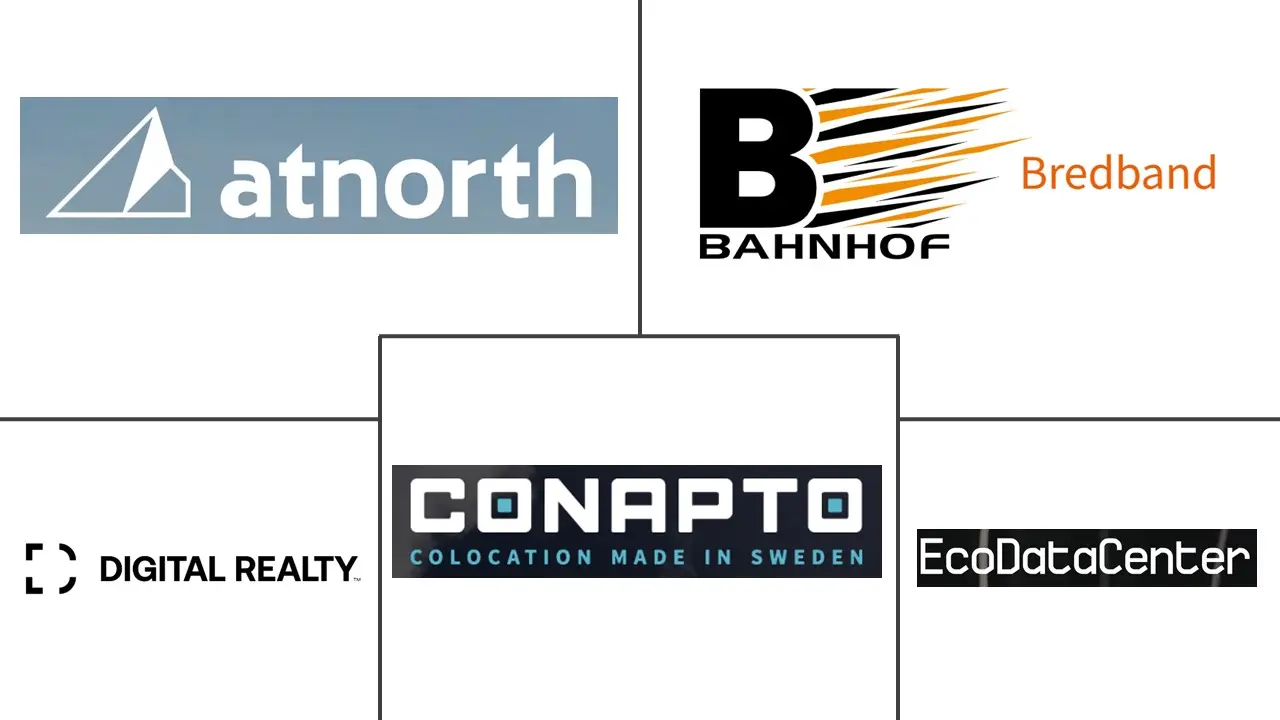Stockholm Data Center Market Size and Share
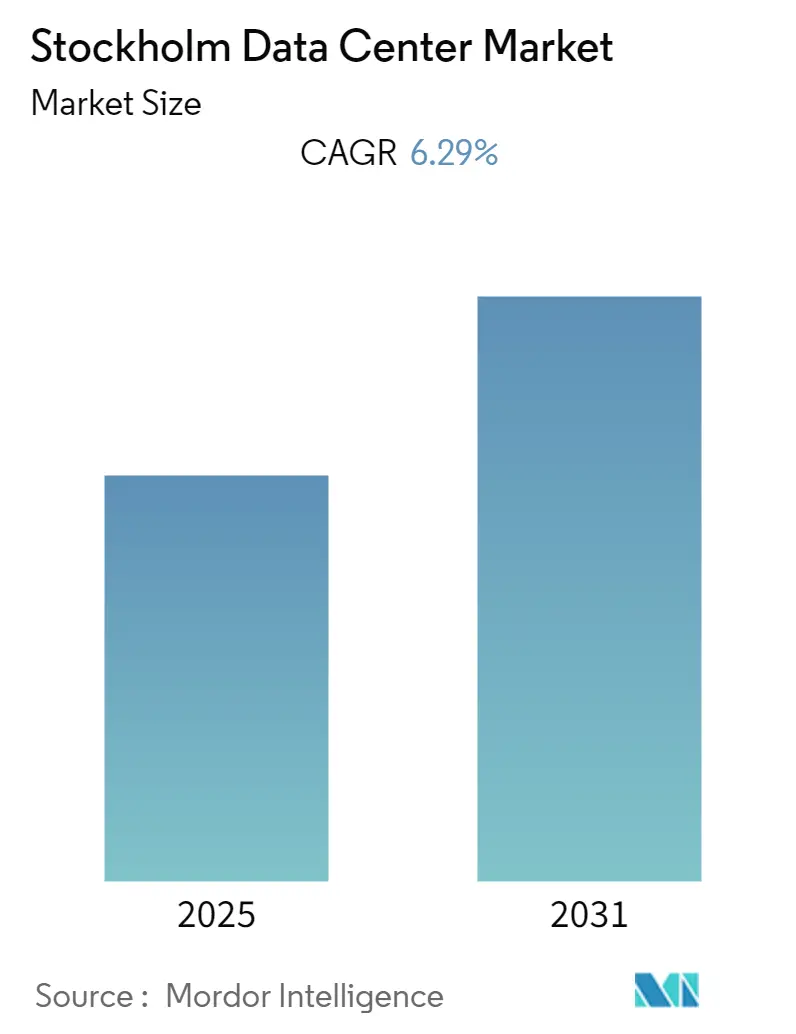
Stockholm Data Center Market Analysis by Mordor Intelligence
The Stockholm Data Center Market is expected to register a CAGR of 6.29% during the forecast period.
The main drivers anticipated to drive market expansion are the increasing demand for energy-efficient data centers, considerable investment by colocation and managed service providers, and expanding hyperscale data center buildings. Additionally, the development of big data, cloud computing, and the Internet of Things (IoT) has made it possible for businesses to invest in new data centers to preserve business continuity.
- Additionally, industrial development is expected to prosper due to the rising need for security, operational efficiency, improved mobility, and bandwidth. Software-based data centers boost industry growth by providing a higher level of automation.
- As individuals spend more time online, telcos require more servers and low-latency connectivity choices. The scale and interconnectedness of hyperscale data centers will be needed to satisfy growing demand. In 2023, services will be dispersed, deployed, and operated over various resources, such as private or public cloud services, networks, and devices, all of which will continue to work in unison to deliver a single service or package of services. Private clouds give greater control and security, whereas public clouds offer enormous processing capacity. Trends like these are expected to drive the studied market.
- For instance, recently, Microsoft Corporation opened its newest sustainable data center region in Sweden, with locations in Gävle, Sandviken, and Staffanstorp. Microsoft's new world-class data centers in Sweden are now operational. Microsoft Azure and Microsoft 365 services are available immediately, providing advanced data protection, privacy, and the opportunity to store data in the country. The new data center region incorporates the best of Microsoft's sustainability investments, powering the data center with 100% carbon-free energy and supporting zero-waste operations, highlighting Microsoft's ongoing investment to help create new long-term opportunities in Sweden's commercial and public sectors.
- Further, in October 2022, the SciLifeLab Research Data Management (RDM) Guidelines web portal will be released. The portal, which SciLifeLab Data Center and NBIS created and maintained, will be a knowledge hub for managing life science research data in Sweden. It will include guidance on best practices for each phase of the research data life cycle, adherence to the FAIR principles, how to make user data as open as feasible, and how to maximize the research effect of data. The information will be specifically designed to relate to life science data from a Swedish research standpoint.
- On the flip side, development centers have conducted extensive research on energy efficiency in data centers, focusing on optimal QoS, efficient utilization of resources, and operation cost reduction. They aim to minimize brown energy utilization by proposing a load-balancing approach utilizing the available green energy. Load balancing is based on available renewable energy and has been installed in multiple data centers. A workload and energy management scheme was introduced to decrease the operational cost of the network and energy costs. Combined cooling, heating, and power (CCHP) systems can reduce carbon emissions and air pollution and increase resource efficiency.
Stockholm Data Center Market Trends and Insights
Tier 4 is Expected to Hold Significant Share of the Market
- The tier-IV certification is currently the highest classification among data center facilities. These data centers require huge capital compared to other tiered data centers and are usually present in developed economies. Sweden is still a developing data center market with an internet penetration of about 50%. The low-tiered data centers in Sweden more feasibly handle the amount of traffic generated. The companies have shown less interest in having facilities with tier IV status in the region.
- Major companies, like Microsoft and Amazon, which operate massive data centers in other regions, have restricted their operations to lower-tiered data centers in Stockholm. Companies like NTT have shown interest in having tier IV facilities in the future. Still, significant investments and expansions have been more toward tier II and III data centers. Moreover, tier-IV providers have redundancies (2N+1) for every process and the data protection stream. No single outage or error can shut down the system and provide 99.9 % uptime annually, the highest guaranteed uptime. The level IV infrastructure should have at least 96 hours of independent power to qualify in this tier. This power should not be connected to any outside source and should be entirely proprietary.
- This tier also ensures optimized efficiency. The servers are housed in the most physically advantageous locations. This drastically extends the life of the hardware. If temperature and humidity are kept consistent, one can gain great efficiency. Even backups and dual power sources are treated like primary sources. Also, the tier-IV data center can require up to 3 to 1 of the space required to facilitate the IT footprint. For tier IV, the kW cost component is USD 25,000 per kW of the redundant UPS capacity for IT.
- Tier IV is considered an enterprise-level service. Companies without international reach and consistently high web traffic do not usually require Tier IV facilities. Tier IV has As technological advancements, such as AI, IoT, and 5G, are leading the digital transformation, various industry sectors, such as government, finance, media, and manufacturing, are starting to demand advanced data centers with high reliability. By leveraging their years of expertise, only some prominent technological vendors in the region are launching services allowing end-users to better manage data center operations.
- According to GSMA Intelligence, Sweden had 14.77 million cellular mobile connections by the beginning of 2023. Further, mobile connections in Sweden were comparable to 139.6 percent of the population in January 2023. The trends in mobile technology, particularly smartphones, have had a significant impact on the data center industry. With the proliferation of mobile devices and the rise in mobile data usage, data centers have had to adapt to handle the increasing demand for mobile services.
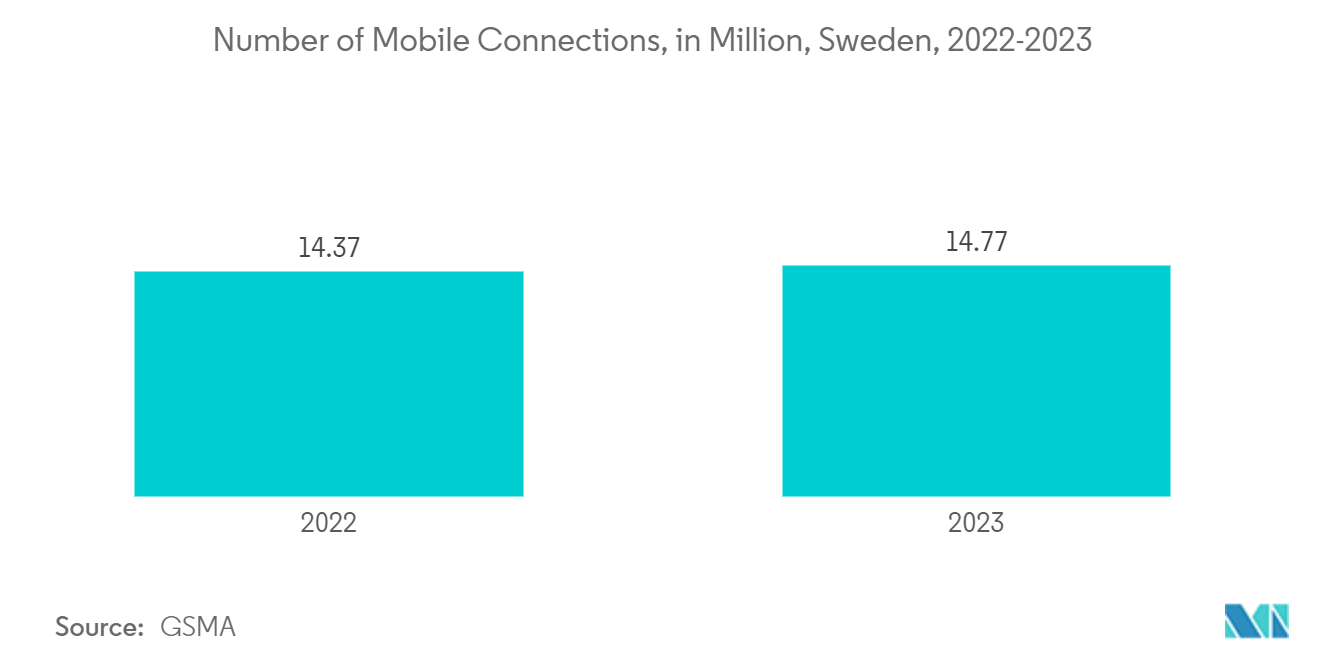
Retail Colocation Center is Expected to Hold Significant Share
- Retail colocation is where the customer leases space within the data center, such as rack space within the caged-off area. Owing to various advantages, such as economics and ease of maintenance, smaller enterprises generally prefer retail colocation. Owning a data center is not a viable option due to the cost of land leasing. Also, maintenance of a colocation center is often outside budget constraints.
- The high demand for colocation services from developing countries drives the retail colocation market. Compared to wholesale colocation services, retail colocation services are highly suitable for enterprises requiring less computing power at one site or across multiple locations to benefit local and global customers. The retail colocation market is anticipated to grow significantly during the forecast period. About 100 kW of energy is typically needed to power retail data centers, while wholesale customers usually need more than 100 kW, owing to their business scale. Many facilities, such as security provision, customer support, cooling facilities, etc., are provided by colocation suppliers.
- Typically, retail customers have many partners to maintain connectivity. Therefore, a diverse set of carriers with good speeds is necessary. Additionally, as retail data center providers work with more clients than wholesale providers, their facilities usually offer a multitude of networks and services. Retail providers offer various services, such as smart hands and remote hands, for technical assistance, managed services, and network monitoring. Therefore, resolving issues can be as simple as raising a service ticket. Such services help exploit various other benefits, such as locating data centers away from disaster-prone areas that can be remotely operated. Due to this remote hand's technology, tax benefits in different states can be used to avail certain tax benefits.
- Many new technologies, including 100% green data centers, have been deployed in retail colocation. Aruba SPA has built a 100% green data center facility. This facility uses underground flowing rivers to turn turbines, solar panels, and underground water pumped to the surface for cooling. The need for interconnectivity is also increasing, increasing the demand for retail colocation. It has been identified that the leading providers of colocation services offer as many as 230,000 interconnection possibilities. Many SME industries constitute a large part of the economy. Such SMEs can only afford part of the space for utility, as the IT staff and operations are included in this scale of operation.
- According to the European Commission, the annual aggregate digital economy and society index (DESI) scores of SWDEN increased to 65.22 in 2022 from 45.71 in 2017. Such a rise in digital scores would allow the study market to grow. Since retail colocation facilities have become old and outdated, their customers are choosing to leave these facilities to find other, newer, multi-tenant data center providers. When retail colocation facilities lose customers, this presents itself in their customer churn metrics. Indeed, public data center companies report churn metrics quarterly, with higher churn implying that more customers are leaving.
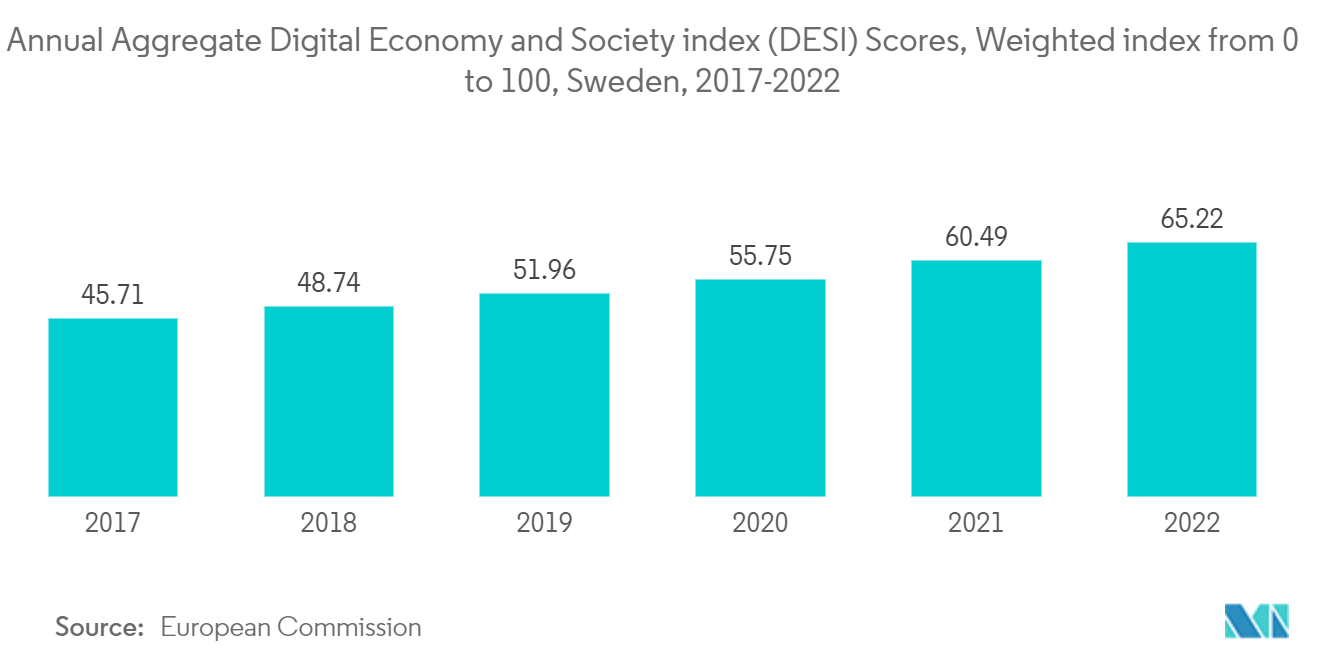
Competitive Landscape
The Stockholm data center market is semi-consolidated, with major players like AtNorth, Bahnhof, Conapto (Designrepublic.se), etc. The companies continuously invest in strategic partnerships and product developments to gain substantial market share. Some of the recent developments in the market are:
In October 2022, Conapto of Sweden broke ground on a new data center in Stockholm. The data center operator has inked an agreement with real estate company Fastpartner to create a 10,000 sq m (107,650 sq ft) data center property in southern Stockholm. The Stockholm 4 site, when fully built, would host an 8,000 sq m (86,100 sq ft) data center and 24 MW of power; Phase 1 will be a 4,000 sq m (43,000 sq ft) two-story data center. The foundation has been laid, and phase 1 is scheduled to open in October 2023.
In March 2022, atNorth, an Icelandic colocation business, opened its first data center in Sweden. According to the corporation, its Kista facility in Stockholm is currently operational. According to the company, the data center is the first in Sweden to be specifically designed for high-density workloads such as advanced calculations for AI, simulations, and risk assessments. Construction on the first phase of the SWE01: SIF DC facility in northern Stockholm began in late 2020, with the first 1.5 MW data hall scheduled to open in December 2021. When completed, the data center would cover 6,400 square meters (68,900 square feet) and have a more than 11 MW capacity.
Stockholm Data Center Industry Leaders
-
atNorth
-
Bahnhof AB
-
Conapto (Designrepublic.se)
-
Interxion(Digital Realty Trust, Inc.)
-
EcoDataCenter
- *Disclaimer: Major Players sorted in no particular order
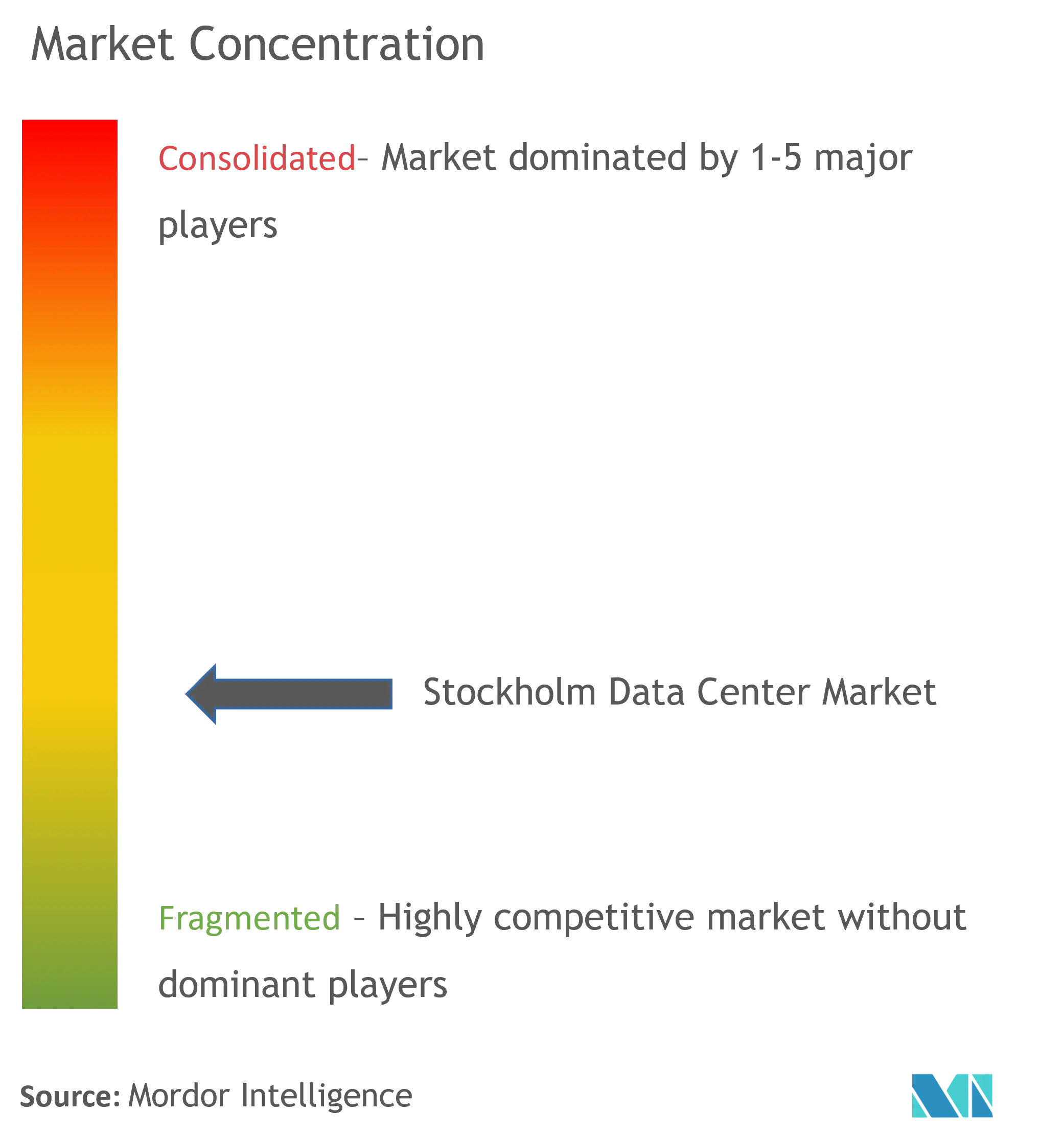
Recent Industry Developments
- April 2023: Conapto, a Nordic data center operator, has secured over USD 40 million in debt funding to help it grow its footprint in Sweden. Conapto, a Swedish data center provider, is adding an extra 20 MW of electricity capacity after getting SEK 400 million in debt financing from Kommunalkredit Austria AG, according to investment firm Marguerite. According to Marguerite, the investment will finance the first phase of a new 8,000-square-meter data center in Stockholm, Sweden, which will be connected to the district heating network to recover excess heat from its operations.
- March 2023: Bahnhof, a Swedish data center operator, intends to construct a nuclear reactor to power a new data center. The company, best known for its Pionen facility, which is designed to look like a James Bond villain's lair, is putting together plans for a small modular reactor (SMR) on an industrial site in Stockholm's Hjorthagen neighborhood, which would provide electrical power for a new data center as well as 30,000 households, as well as heat for homes and offices.
Stockholm Data Center Market Report Scope
A data center is a physical room, building, or facility that holds IT infrastructure used to construct, run, and provide applications and services and store and manage the data connected with those applications and services.
The Stockholm data center market is segmented by DC size (small, medium, large, massive, mega), by tier type (tier 1 and 2, Tier 3, Tier 4), by absorption (utilized, colocation type (retail, wholescale, hyperscale), end user (cloud & IT, telecom, media & entertainment, government, BFSI, manufacturing, e-commerce)), and non-utilized). The market sizes and forecasts are provided in terms of value (MW) for all the above segments.
| Small |
| Medium |
| Large |
| Massive |
| Mega |
| Tier 1 & 2 |
| Tier 3 |
| Tier 4 |
| Utilized | Colocation Type | Retail |
| Wholesale | ||
| Hyperscale | ||
| End User | Cloud & IT | |
| Telecom | ||
| Media & Entertainment | ||
| Government | ||
| BFSI | ||
| Manufacturing | ||
| E-Commerce | ||
| Other End-User | ||
| Non-Utilized | ||
| DC Size | Small | ||
| Medium | |||
| Large | |||
| Massive | |||
| Mega | |||
| Tier Type | Tier 1 & 2 | ||
| Tier 3 | |||
| Tier 4 | |||
| Absorption | Utilized | Colocation Type | Retail |
| Wholesale | |||
| Hyperscale | |||
| End User | Cloud & IT | ||
| Telecom | |||
| Media & Entertainment | |||
| Government | |||
| BFSI | |||
| Manufacturing | |||
| E-Commerce | |||
| Other End-User | |||
| Non-Utilized | |||
Key Questions Answered in the Report
What is the current Stockholm Data Center Market size?
The Stockholm Data Center Market is projected to register a CAGR of 6.29% during the forecast period (2025-2031)
Who are the key players in Stockholm Data Center Market?
atNorth, Bahnhof AB, Conapto (Designrepublic.se), Interxion(Digital Realty Trust, Inc.) and EcoDataCenter are the major companies operating in the Stockholm Data Center Market.
What years does this Stockholm Data Center Market cover?
The report covers the Stockholm Data Center Market historical market size for years: 2019, 2020, 2021, 2022, 2023 and 2024. The report also forecasts the Stockholm Data Center Market size for years: 2025, 2026, 2027, 2028, 2029, 2030 and 2031.
Page last updated on:
Stockholm Data Center Market Report
Statistics for the 2025 Stockholm Data Center market share, size and revenue growth rate, created by Mordor Intelligence™ Industry Reports. Stockholm Data Center analysis includes a market forecast outlook for 2025 to 2031 and historical overview. Get a sample of this industry analysis as a free report PDF download.
